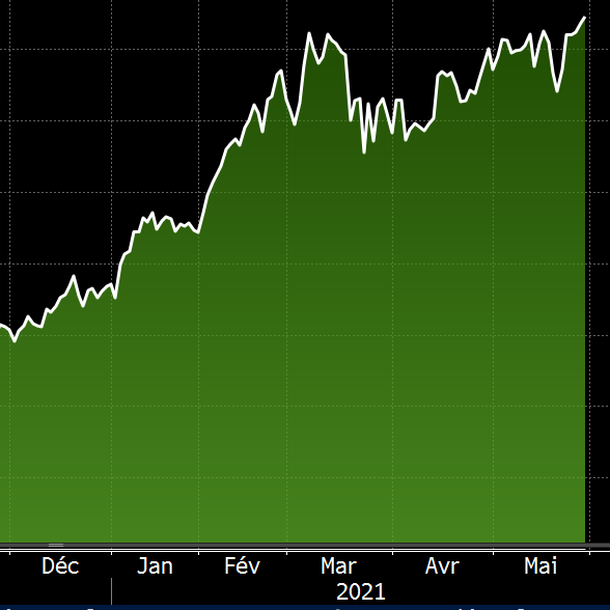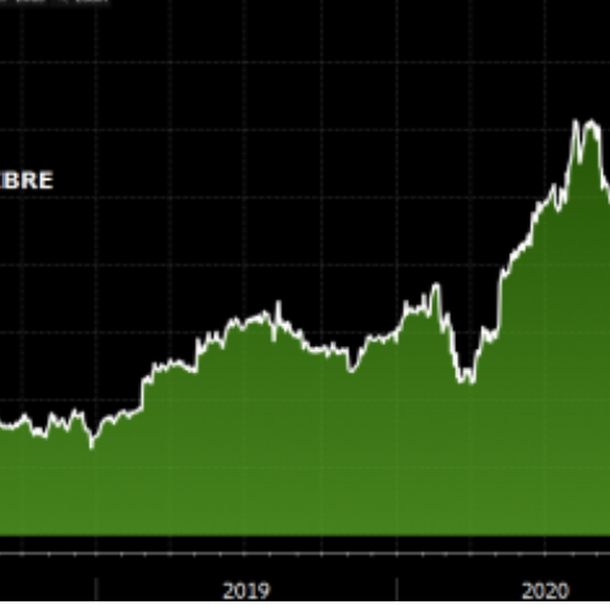|
Monday November 30 | Weekly market update |
 | European markets have just posted a fourth consecutive week of gains, driven by the performance of cyclical stocks, while recent announcements on vaccines against Covid-19 are rekindling hopes of an improvement in the global economic outlook. While Europe is returning to early-year levels, Wall Street is setting new all-time records as the year-end buying season begins. |
| Indexes In Asia, the Nikkei recorded a weekly performance of 4.4%, the Hang Seng 1.4% and the Shanghai Composite 0.9%. For the euro zone, the major indices continued to rise. The CAC40 gained 1.9%, the Dax and the Footsie 1.5% and 0.2% respectively. The gains were more significant for the peripheral countries of the euro zone, as was the 5.1% increase in the Portuguese index. Spain rose 2.3% and Italy 2.8%. In the U.S., indexes set new absolute records in turn. The Dow Jones was up 2.2% for the week, the S&P500 was up 2.3% and the Nasdaq100 was up 3.1%. |
| Commodities Oil had a remarkable week, strongly supported by prospects for a recovery in demand following vaccine announcements. OPEC+ is also contributing to this optimism, as the expanded cartel is expected to postpone the production increase planned for January 2021. As a result, Brent crude oil is trading at US$47.5, compared with US$44.7 for WTI (see graph). The same cannot be said for gold, which suffers from a risk-taking environment. Investors are in a hurry not to miss their train on equities, oil and base metals, to the detriment of safe havens. The gold metal is thus evolving below USD 1,800. Silver shows a little more resilience at USD 22.6. The rally in base metals continued this week, with copper reaching a new annual high at $7,356 per metric ton. Progression of the WTI  |
| Equities markets You all know Alibaba, Amazon and Rakuten, the titans of e-commerce. South America also has its champion. Admittedly, it is much smaller than its rivals, in terms of market capitalization (nearly $73.7 billion against almost $1600 billion for Amazon). The fact remains that MERCADOLIBRE INC, an Argentine company listed on the Nasdaq, has 28% of the market share in Latin America. By way of comparison, Amazon has 4%. Leader in a rapidly expanding market, the company is present in 18 countries including Argentina, Brazil and Mexico. Revenue growth in these countries was +145%, +57% and +111% respectively, reflecting a very positive growth trend in the region. The South American market has a population of nearly 650 million inhabitants. Today, nearly 100 million people use Mercadolibre platforms. In addition to its strategic position in a booming market, the consensus forecasts EBITDA growth for the next three years. In addition, over the last four months, the consensus has revised upwards. The only downside to this stock is its very high valuation. Stock market performance reflects these good fundamentals, with advances of 158% over 2020 and 2180% over the last ten years. MercadoLibre share performance  |
| Bond market During Thanksgiving week, the lack of interest in the bond market was apparent and the Tbond moved in a narrow band of fluctuation at 0.85%. In Europe, the Bund curve flattened slightly from the long side. Contributing to this result were comments by ECB Chief Economist Lane, who warned that the macroeconomic recovery should not be jeopardized "by a premature steepening of the yield curve". The German benchmark retains its yield at -0.55%, as does the French OAT at -0.13%. The only remarkable thing about the week was the Portuguese 10-year bond rate which, for the very first time, symbolically went into negative territory. Spain is not far off at 0.09%. |
| Forex market Some optimism on the Brexit front is helping the pound rise. Forex traders are betting that British leaders will have to be realistic and agree to a deal before the end of the year. The British currency is gaining ground against all of its major counterparts, such as the dollar, which is trading at $1.34, a two-month high. Still in Europe, the single currency is showing resilience against the greenback and is back on the USD 1.19 line. The strengthening of the euro is also evident against the Swiss franc at CHF 1.08 and against the yen at JPY 124.5. The risk appetite on financial markets has therefore served both safe havens. The greenback is still suffering against the Chinese currency and is trading on its lows at CNY 6.54, while the Swedish krona is at the zenith of its form against major currencies including the euro at SEK 10.10. Among emerging currencies, the Turkish lira still shows a lot of volatility. Since the ouster of the central bank governor and the resignation of the finance minister, Turkey has raised interest rates to a two-year ceiling, boosting the currency from its low point of TRY 8.5 last October. Continued weakening of the dollar index  |
| Economic data European statistics were few last week, but for the most part better than expected. In Germany, GDP grew by 8.5%, the IFO rose to 90.7 (90.3 expected and 92.5 last month) and import prices remained at +0.3%. The Flash PMI manufacturing and services indices came out at 57.9 and 46.2 respectively. These same indices were contrasted in the euro zone, exceeding expectations for manufacturing activity (53.6 against 53.2 expected and 54.8 previously), but falling to 41.3 for services (42.2 expected and 46.9 last month). In the U.S., activity is accelerating (56.7 for industry and 57.7 for services). GDP continues to grow strongly by 33.1%, orders for durable goods rebounded by 1.3% while new housing sales rose to 999K. On the other hand, household spending and income were mixed (+0.5% and -0.7% respectively) and weekly unemployment registrations rose to 778K (732K expected). |
| Risk taking is here to stay The powerful revival of the European indices, accompanied by new records on Wall Street, has so far shown no weakness. The gradual easing of restrictions on the old continent, with a new weapon to control the pandemic and unlimited support from central banks, is encouraging players to intensify their positions as the new year looms. After shifting focus towards cyclicals, which are lagging far behind, investors could set themselves new challenges. The improvement in the next few quarters as the economy catches up favors risk taking, fuelling the robust performance of equities. It should be noted once again that the exceptionally advantageous monetary environment offers few alternatives to this type of investment, especially if economic activity returns to some degree of normalization. |

 By
By 














